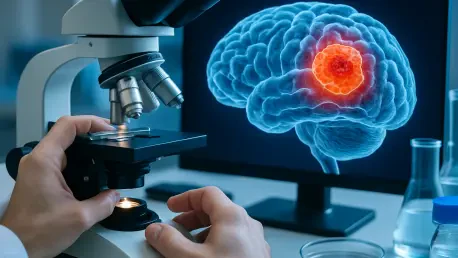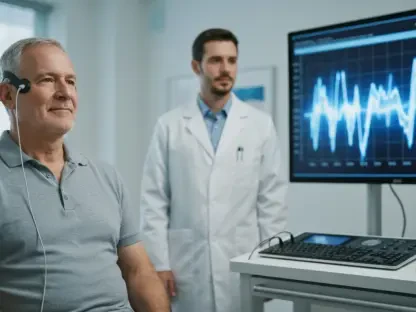In a transformative moment for medical research, a Newcastle-based team at the University of Newcastle and the Hunter Medical Research Institute (HMRI) has secured a staggering $18.7 million grant from the Australian Government’s Medical Research Future Fund (MRFF) to combat one of the deadliest forms of brain cancer, known as high-grade gliomas (HGG). Led by Professor Matt Dun, this ambitious project targets aggressive diagnoses such as diffuse intrinsic pontine glioma (DIPG) in children and glioblastoma in adults, conditions that currently offer little to no hope for survival.
Confronting a Devastating Health Crisis
Every year, over 2,000 Australians receive the harrowing diagnosis of high-grade gliomas, a group of brain cancers notorious for their aggressive nature and resistance to treatment. The location of these tumors in delicate brain regions often renders surgical removal risky or impossible, compounding the challenge for medical professionals. Additionally, the blood-brain barrier, a natural defense mechanism that protects the brain from harmful substances, inadvertently blocks most conventional chemotherapies from reaching their target. This has resulted in stagnant progress for decades, with survival rates remaining dismally low, especially for children with DIPG who rarely survive beyond a year even with radiotherapy. The urgent need for new approaches to tackle this public health crisis cannot be overstated, as current options fail to address the unique obstacles posed by HGG, leaving patients and families in desperate need of a breakthrough.
The impact of HGG extends beyond mere statistics, touching countless lives with profound loss and hardship. For adults diagnosed with glioblastoma, which constitutes 65% of brain cancer fatalities, the lack of effective therapies means that even aggressive interventions often yield minimal results. The complexity of these tumors, driven by intricate genetic and immunological factors, further complicates the development of viable treatments. This reality underscores the critical importance of innovative research that can navigate these barriers and offer a glimmer of hope. The $18.7 million grant awarded to Professor Dun’s team is a direct response to this pressing need, aiming to dismantle the longstanding challenges that have hindered progress. By focusing on novel strategies, this initiative seeks to rewrite the narrative for those battling HGG, providing a potential path forward where none currently exists.
Pioneering New Treatment Pathways
At the heart of this groundbreaking research lies a bold scientific strategy to target a specific gene identified as a key driver of HGG tumor growth. Professor Dun and his team are developing brain-penetrant drugs designed to inhibit this gene, a method that has shown extraordinary promise in preclinical studies by extending survival rates by over 150%. Unlike traditional approaches, these drugs are engineered to cross the blood-brain barrier, addressing one of the most significant obstacles in brain cancer treatment. Combined with radiotherapy and other targeted therapies, this multifaceted approach aims to disrupt the tumor’s ability to thrive, offering a potential lifeline to patients. With a goal to advance these therapies to clinical trials within five years, the project represents a significant leap forward in a field that has seen little advancement for far too long.
This innovative focus on next-generation treatments marks a departure from the limitations of past efforts, which often relied on broad, ineffective methods like standard chemotherapy. The tailored nature of these new drugs reflects a deeper understanding of the genetic underpinnings of HGG, allowing for a more precise attack on the cancer’s mechanisms. Such precision is crucial when dealing with tumors as complex and variable as glioblastomas and DIPG, which often adapt to resist conventional interventions. By prioritizing therapies that can penetrate the brain’s natural defenses, the research team is not only addressing immediate challenges but also laying the groundwork for future advancements. The hope is that these early successes in preclinical models will translate into tangible outcomes for patients, shifting the paradigm of care for those facing these devastating diagnoses.
Harnessing the Strength of Global Teamwork
A defining feature of this initiative is its emphasis on collaboration, often described as “team science at its finest.” The project brings together a vast network of leading researchers, clinicians, and translational experts from institutions such as the University of New South Wales, Children’s Cancer Institute, Stanford University, and multiple Australian hospitals. This global partnership ensures a pooling of diverse expertise and resources, significantly enhancing the chances of overcoming the multifaceted challenges posed by HGG. Each collaborator contributes unique insights, from cutting-edge scientific techniques to clinical perspectives, creating a robust framework for innovation. Such collective effort is essential when tackling a condition as intricate as brain cancer, where no single approach or institution can address the full scope of the problem alone.
The collaborative model also mirrors a broader trend in medical research, where interdisciplinary and international alliances are increasingly recognized as vital to solving complex health issues. By uniting minds across borders and specialties, the project maximizes its potential for success, ensuring that no stone is left unturned in the pursuit of a cure. This approach not only accelerates the development of new therapies but also fosters a shared sense of purpose among the scientific community. The involvement of prestigious institutions lends credibility and momentum to the initiative, signaling to the wider field that HGG research is a priority worth pursuing. As this network continues to expand and refine its efforts, it sets a powerful example of how unity can drive progress in even the most daunting medical challenges.
A Personal Mission with Universal Impact
Behind the scientific rigor of this project lies a deeply personal story that fuels its relentless pursuit of a cure. Professor Dun’s drive is rooted in the heartbreaking loss of his daughter Josephine, who succumbed to DIPG in 2019 after a valiant battle. This profound experience has imbued the research with an emotional intensity, transforming it into more than just a professional endeavor—it’s a mission to prevent other families from enduring similar pain. The resonance of this motivation extends far beyond one individual, touching the lives of countless patients, caregivers, and clinicians who grapple with the hopelessness often associated with HGG diagnoses. It serves as a poignant reminder of the human stakes at play in medical research, where every breakthrough carries the weight of personal stories.
This personal connection also amplifies the broader community’s investment in the project’s success, creating a collective resolve to see it through. Families affected by brain cancer find solace in knowing that researchers are not only driven by data but also by a shared understanding of their struggles. The emotional undercurrent of the initiative bridges the gap between laboratory work and real-world impact, ensuring that the ultimate goal remains focused on improving lives. While the scientific challenges of HGG are formidable, the human element provides an unwavering source of inspiration, pushing the team to explore every possible avenue for a solution. As this mission progresses, it carries with it the hopes of many, embodying a commitment to transform tragedy into tangible hope for future generations.
Embracing the Era of Precision Medicine
The research initiative aligns seamlessly with a transformative shift in cancer treatment toward precision medicine, a strategy that prioritizes targeted therapies over the one-size-fits-all approaches of the past. Traditional methods like standard chemotherapy and surgery have proven largely ineffective against HGG due to the tumors’ unique characteristics and protective barriers. In contrast, the development of drugs tailored to specific genetic drivers of these cancers represents a more promising path forward. The $18.7 million grant, part of a larger $700 million MRFF Frontier commitment to ambitious “moonshot” projects, underscores the growing recognition of precision medicine’s potential. It also highlights the critical need to address historically underfunded areas like brain cancer, which have long been sidelined despite their devastating toll.
This shift in focus is not just a response to immediate needs but a reflection of evolving priorities within the medical research community. By investing in innovative, high-risk projects, funding bodies are signaling a willingness to tackle seemingly insurmountable challenges with bold strategies. The validation of Professor Dun’s work through this substantial grant serves as a catalyst for further exploration into personalized treatments, potentially reshaping how other complex cancers are approached. Moreover, it draws attention to the disparities in research funding, urging stakeholders to prioritize conditions with unmet needs. As precision medicine continues to gain traction, initiatives like this one pave the way for a future where treatments are as unique as the patients they serve, offering renewed optimism in the fight against deadly diseases.
Envisioning a Wider Impact on Healthcare
The implications of this research extend well beyond the realm of high-grade gliomas, holding promise for a range of neurological conditions and medical fields. Successfully developing therapies that can cross the blood-brain barrier could open doors to treating other disorders, such as Alzheimer’s or Parkinson’s, where similar obstacles have stymied progress. This breakthrough potential underscores the far-reaching value of the project, positioning it as a cornerstone for future innovations in brain health. Additionally, the collaborative framework established by the team offers a replicable model for addressing other complex health challenges, demonstrating the power of unified expertise in driving meaningful change across disciplines.
Looking ahead, the initiative also sets a precedent for sustained investment in underfunded areas of medicine, encouraging policymakers and organizations to commit resources to high-impact research. The success of this project could inspire similar efforts, fostering a culture of bold experimentation and teamwork in the scientific community. As advancements unfold over the coming years, particularly with the aim of reaching clinical trials within a five-year span, the ripple effects may redefine treatment landscapes for numerous conditions. Ultimately, this grant represents more than just a financial boost—it’s a catalyst for systemic progress, offering a blueprint for how dedication, innovation, and collaboration can transform the future of healthcare for the better.









